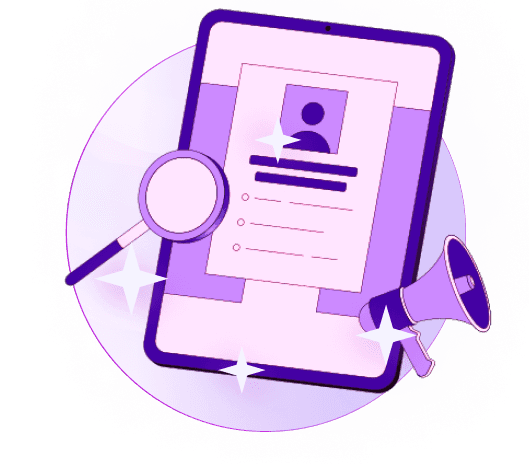Blogs
Articles

B2B Buying Signals: What They Are and How to Use Them
B2B buying signals offer a solution. These signals show up as behavioral patterns, actions, and events that suggest a company is ready to buy. Think of them as digital breadcrumbs that prospects leave behind when they search the market for solutions like yours.
Spotting these signals isn't easy. Buying committees now include 9 people on average. Only 5% of your target audience looks for solutions at any time. This makes finding the right opportunities a vital part of the process.
Here's something unexpected: Most B2B purchases start with a trigger event rather than a marketing campaign. Companies typically wait for a compelling reason before they start looking for solutions. That's why 84% of deals end before providers know they exist.
This piece will take a closer look at what buying signals mean in B2B, explore different signal types you should track, and show you how to build a signal-based sales program that works.
Let's see how you can better identify and convert opportunities in the B2B purchase process.
What are B2B buying signals?
B2B buying signals show how ready companies are to buy products or services through their digital and real-world behaviors. These signals range from simple website visits to direct requests for pricing details. Sales teams gain an edge by spotting which accounts will likely convert.
Explicit vs. implicit signals
Explicit signals clearly show buying interest without much need for interpretation. These include:
Requesting a product demonstration
Downloading pricing information
Filling out contact forms
Attending a sales webinar
Direct questions about features
Implicit signals need deeper analysis to understand. These subtle clues might include:
Several team members from one company visiting your website
Extra time spent on product pages
Patterns in content engagement (like reading case studies)
Brand interactions on social media
Job listings that hint at needing your solution
The difference matters because explicit signals usually show late-stage interest, while implicit signals help find prospects early in their buying experience.
Buying signals meaning in B2B context
B2B buying signals have special importance because of complex purchasing processes. Business purchases differ from consumer buying - they need multiple decision makers, take longer to close, and involve bigger investments.
B2B buying signals are valuable because they reveal:
Purchase timing - Companies actively looking for solutions
Budget allocation - Available financial resources
Decision-maker involvement - Key stakeholders in the process
Pain points - Specific challenges driving purchase decisions
Competitive positioning - Other vendors under consideration
B2B buying signals appear on many platforms and touchpoints because businesses research extensively before buying. Sales teams that spot these patterns can reach out at the perfect time - not too soon to seem aggressive, but early enough to catch the opportunity.
Types of Buying Signals to Track

Identifying high-potential prospects in the B2B space depends on tracking the right buying signals. Sales teams can connect with prospects at the perfect moment by understanding these signals during their buying process.
Behavioral signals
Prospects leave traces of their interaction with your brand across various touchpoints. Website visits to pricing or product pages, content downloads, email interactions, and social media activity serve as key indicators. Strong interest becomes evident when prospects make multiple visits to pricing pages or view several pages in one session. Your prospect's engagement level becomes clear through their website behavior, such as scroll depth and time spent reading specific content.
Intent signals
Prospects show active interest in solutions like yours through intent signals. These emerge from their content consumption across publisher networks, keyword searches on external sites, and activity on G2 and Capterra. Third-party intent data combines billions of online browsing events to establish normal company content consumption patterns. This helps detect substantial spikes in topic interest. Your team can spot interested prospects before they make direct contact by monitoring these patterns.
Firmographic and technographic signals
Company attributes like industry, size, revenue, and location make up firmographic signals. Technographic signals show which technologies companies use, from CRM platforms to cloud infrastructure. These signals help match prospects to your ideal customer profile and identify their technological needs. A prospect's use of Salesforce, for example, lets you present your product as a compatible solution.
Custom and product-led signals
Your business model determines specific custom signals and product-led indicators. Product-led signals measure user interaction through freemium-to-paid conversions, feature usage, login frequency, and support requests. Business events like new leadership, funding rounds, or regulatory changes that create fresh opportunities fall under customer triggers.
Buying signals examples from real scenarios
A prospect might download your whitepaper and schedule a product demo within two days. Some prospects open your outreach emails several times before scheduling a pricing discussion. HR directors sometimes view your LinkedIn profile, connect with you, and ask about implementation schedules.
Why Buying Signals Matter in the B2B Purchase Process?
Sales and marketing operations in B2B sales and marketing improve significantly when teams spot buying signals. Organizations that use these indicators see 40-50% higher win rates compared to others.
Improving lead qualification
More than 40% of salespeople find prospecting the toughest part of their sales process. Buying signals help sales teams focus on valuable leads instead of chasing unqualified prospects. Companies can prioritize leads showing real interest by tracking their website visits and content interaction.
Personalizing outreach with immediate data
Personalized interactions matter to modern B2B buyers 73% just need consumer-like experiences. Sales teams can craft relevant messages that target actual pain points instead of generic pitches by using buying signals to learn about prospects' specific challenges.
Arranging sales and marketing teams
Both departments work as one unit with buying signals that create a single source of truth. Marketing teams deliver qualified leads with clear context and sales provides ground insights about prospect objections and needs.
Shortening the sales cycle
Companies that watch buying signals report up to a 40% increase in successful conversions. The sales cycle becomes 30% shorter when teams involve prospects during peak interest moments.
Avoiding wasted outreach
Sales reps have seven times better chances of meaningful conversations with decision-makers if they reach out within an hour of spotting a buying signal. This precision removes ineffective cold outreach and puts resources where they create the best results.
How to Build a Signal-Based Sales Program?
A successful signal-based sales program needs systematic execution and reliable tech infrastructure. Your program's success relies on detecting and responding to buyer signals throughout the B2B purchase cycle.
Identify buying signals using tools and platforms
Your sales motion should guide which triggers to track. Start with 2-3 high-value signals such as:
Job changes (ideal for relationship-led selling)
Website visits (perfect for inbound follow-up)
Funding rounds or hiring (effective for outbound sales)
Keyword intent spikes (signals early buying behavior)
Data from multiple sources your CRM, marketing automation platform, website analytics, and third-party intent data providers unite to create a complete view of prospect activities. This gives you insights across all touchpoints.
Score and prioritize signals effectively
Signals carry different weights. Your scoring system should consider:
Signal type (e.g., webinar signup vs. pricing page visit)
Account fit (how close to your ideal customer profile)
This helps your team decide which accounts need immediate attention and which need nurturing.
Create multi-channel engagement strategies
Scored signals help you reach prospects through multiple channels with customized messages. Email marketing, social media, phone calls, and targeted ads work together to deliver a consistent experience. Messages should match the prospect's buying stage and address specific challenges.
Automate workflows with AI and CRM integrations
AI-powered tools can analyze signals and sort leads automatically. These systems assign intent scores to help your team focus on promising prospects. Your signal data should flow into familiar tools CRM fields, browser alerts, or Slack notifications. This lets reps act on signals without extra steps.
Want to boost your signal-based sales program? Persana.ai provides AI-powered solutions to help you spot and act on buying signals.
Track performance and refine over time
Signal-based programs need constant attention. Watch metrics like engagement rates, lead-to-customer conversions, and revenue effects. Review your signal sources and scoring models regularly. Your sales team's feedback will show which signals drive deals forward.
Conclusion
B2B buying signals fundamentally change how sales teams identify and convert prospects. This piece explores how digital breadcrumbs ranging from website interactions to third-party intent data show when companies actively look for solutions like yours.
Timing your outreach depends on the difference between explicit and implicit signals. Explicit signals show late-stage interest. Implicit signals help you spot prospects early in their buying trip. This gives you a competitive edge before competitors spot the chance.
Teams that track and act upon buying signals achieve remarkable results. Their win rates jump by 40-50%. Sales cycles become 30% shorter. Sales-marketing arrangement improves substantially. Teams focus resources on interested prospects instead of wasting time on unqualified leads.
A signal-based program needs careful planning. Start by picking signals that arrange with your sales motion. Next, develop a scoring system that prioritizes prospects based on signal strength and account fit. Create individual-specific multi-channel engagement strategies for each prospect's buying stage. Use automation tools to streamline the process and refine your approach based on performance data.
Note that most B2B purchases start with a trigger event, not a marketing campaign. Companies look for solutions only when something forces them to act. Your knowing how to detect and respond to these signals determines if you'll be part of their decision-making process.
The B2B buying world has changed. Prospects research extensively before talking to sales representatives. Proactive signal detection becomes crucial for sales success. Without doubt, your power to identify and act upon these signals determines how well you convert chances in today's complex B2B purchase environment.
Key Takeaways
Understanding B2B buying signals is essential for modern sales success, as 77% of buyers research independently before engaging with sales reps, making early detection crucial for competitive advantage.
• Track both explicit and implicit signals: Explicit signals (demo requests, pricing downloads) show late-stage interest, while implicit signals (website visits, content engagement) help identify prospects earlier in their journey.
• Focus on high-impact signal types: Monitor behavioral signals (website interactions), intent signals (third-party research activity), firmographic data (company attributes), and product-led signals (user engagement patterns).
• Implement systematic signal scoring: Prioritize prospects based on signal strength, account fit, and frequency of engagement to focus resources on the highest-potential opportunities.
• Automate and personalize outreach: Use AI-powered tools to detect signals automatically and create multi-channel engagement strategies tailored to each prospect's buying stage and specific pain points.
• Measure and refine continuously: Companies using signal-based approaches see 40-50% higher win rates and 30% shorter sales cycles, but success requires ongoing optimization based on performance data.

Create Your Free Persana Account Today
Join 5000+ GTM leaders who are using Persana for their outbound needs.
How Persana increases your sales results
One of the most effective ways to ensure sales cycle consistency is by using AI-driven automation. A solution like Persana, and its AI SDR - Nia, helps you streamline significant parts of your sales process, including prospecting, outreach personalization, and follow-up.



